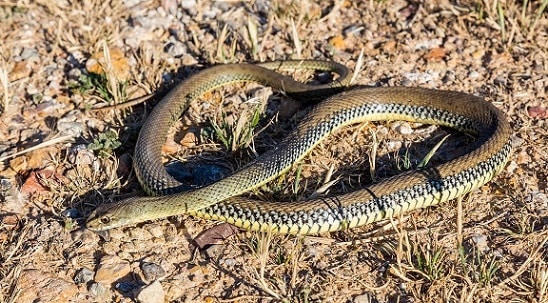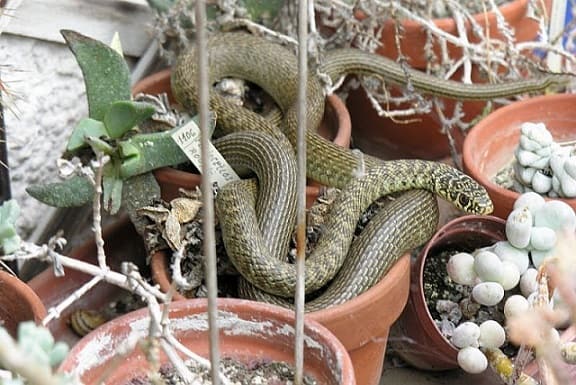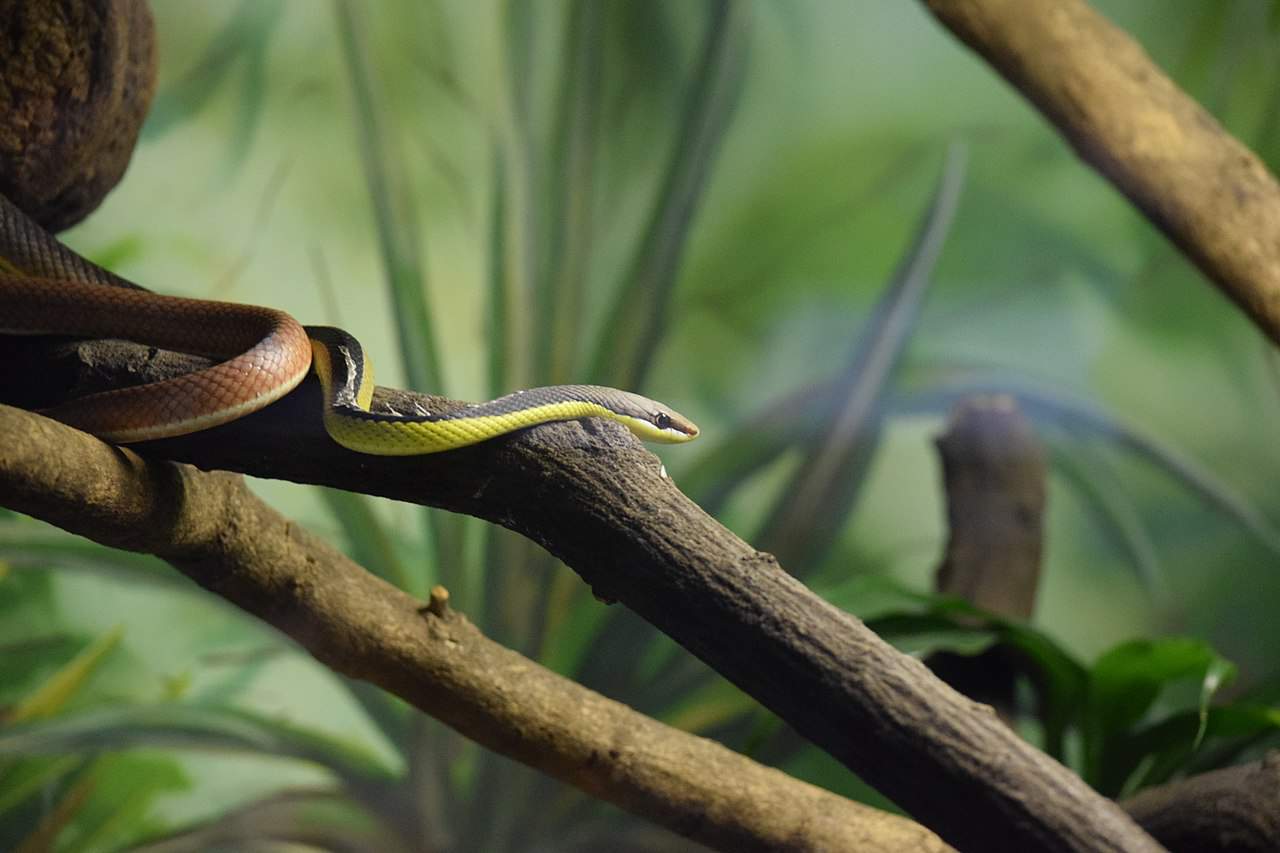| 1 | Montpellier snake |

The Montpellier snake lives in Spain and North Africa, reaches 2 metres, and has a consistent olive-coloured body. This snake isn’t just energetic, but unrelenting and fearless in everything they do. When hunting, they simply charge down their rodent prey and grab. When escaping, they zoom vertically up stone walls and down the other side, the last thing you see being their tail.
Montpellier snakes can pick up scents of a rat colony on the wind and slither 500 metres just to see what’s there. They’re also completely unbothered by human settlements and will continue to zoom around as though they haven’t seen anything. Montpellier snakes are another active forager, and their diet consists of 50% reptiles and 35% mammals. Top species include the wood mouse and Algerian sand racer. Montpellier snakes are themselves hunted by short-toed eagles, which is doubtlessly another reason why their speed has accelerated over time.
It depends on what path a snake chooses from the start. The false smooth snake (also from Spain) chose camouflage, and bird threats will only push them to improve that camouflage. But if species like the Montpellier snake choose to venture into the open country, exposed, then evolution will push them further down the path of agility.
| 2 | Green whipsnake |

The green whipsnake lives in southern Europe, but particularly Italy, where it’s the most commonly sighted snake. This is because it’s a bold, brash snake which slithers around wherever it pleases, in a constant rush.
The green whipsnake is so energetic that they’ve invented a special looping system. The first loop lasts 24 hours and has the purpose of sun exposure, warming their cold-blooded bodies. The second loop lasts 2 days or more and involves exploration and finding more bountiful food supplies. Loop 3 is a mating loop where they search for females, lasting 30 days. Each of these exploration loops travels in a wider arch than the next, the last being 3km.
Green whipsnakes have several defensive moves, but always prefer action. If the way is clear, they’ll speed off down a footpath. If cornered, they’ll lunge while hissing fiercely and bite without hesitation. Green whipsnakes can travel 881 metres in a single day. They dislike the darkest forests, but are common in mixed open areas where they can slither over walls and leap casually from tree branches.
| 3 | Red-bellied black snake |
The red-bellied black snake is easily one of Australia’s most relentlessly active. They don’t hold back in anything they do, whether it’s ripping up lake beds to flush out prey, speeding through car parks, or motoring along dirt tracks. Red-bellied black snakes are very active in winter compared to other Australian snakes, and barely seem to stop moving all day. Most ordinary Australians spot them cruising along paths, rather than lurking in the shadows.
One reason behind their adventurous ways is their taste for frogs, including the emerald spotted tree frog. Frogs tend to congregate in certain swamps, meaning that there’s always a bountiful new food supply somewhere out there to find. This is purely an active forager rather than an ambusher. The red-bellied black snake would go crazy if it followed the lifestyle of the broad-headed snake, which sticks to one bushrock outcrop all its life.
Males have been witnessed travelling 1.22km in a single day, particularly those fuelled by their yearly obsession with female pheromones. That said, this snake does stay within the same general area – they’re just manically active within its borders.
| 4 | Miranda green racer |

This is one of the lesser known snakes living in the Amazon rainforest, particularly Paraguay. The whole jungle is its playground, as the Miranda green racer spends its life zipping up branches and charging between ancient, thick trunks to find its next meal.
The blood python is happy to lie still for weeks, whereas the Miranda green racer gets that restless feeling after only a few hours, which compels them to get moving whether they like it or not. The Miranda green racer (Philodryas mattogrossensis) probably has that feeling you get after sitting on a plane for 9 hours, or like when a gym rat skips his usual morning session.
This snake also has extremely fast reactions, which are used to pounce on its prey. They produce a rear-ranged venom which has never killed on record, but may cause nasty, painful swelling, given similar venoms in other species. Rather than one sudden lunge, the Miranda green racer chews again and again until it’s satisfied enough has been injected. Then it slithers off to complete its next task, whether investigating a bush or threading along the narrow crest of a log. Miranda green racers are recognisable by clearly defined colours; a yellow-green belly and a dark green back. They belong to the same family as Chilean long-tailed snakes.
| 5 | Rhombic skaapsteker |
The rhombic skaapsteker is the resident speed specialist of South Africa, a mildly venomous 80cm snake which appears in various habitats. If you see a distant dust cloud on the horizon, it could be a car, but it could also be a rhombic skaapsteker. This snake commonly takes advantage of paths and trails, as these are simple to zip along. They’re often spotted in dry shrubland with thorny bushes to weave through, and near ponds with an abundance of lily pads.
The speed has likely evolved to help them catch fast-moving meals. Even with their speed, they sometimes miss shrews by mere centimetres. It’s possible that evolution will push rhombic skaapstekers to get even faster over the next 10,000 years.
The rhombic skaapsteker looks like it’s been unscrewed and poured full of caffeine. They grind to a halt as fast as they start, freezing still like their power supply has been disconnected. This is a restless snake which isn’t content to cling to a comfy branch all day. They might last 5 minutes, until curiosity takes over and they decide to investigate that movement they saw on a distant lily pad. Rhombic skaapstekers eat mammals first and lizards second, including rock elephant shrews and montane speckled skinks.
| 6 | Black mamba |
The black mamba’s speed is legendary, with beliefs in villages that they can outrun a fully grown man or even a car. They’re nervous and twitchy, a disturbing fact given that their neurotoxic venom can paralyse a grown man in 10 minutes. The black mamba’s speed isn’t just disturbing, but the fact that they can zoom forward with half their body raised into the air. Somehow they can lift their chest up to scan the horizon without losing any speed.
At up to 4 metres, the black mamba is the second longest venomous snake worldwide. They’re probably the most energetic snake relative to size, as the longest snakes of all are stealthy constrictors, except the king cobra, which isn’t particularly hyper. An oft-cited statistic is that black mambas can slither at 12.5mph, versus an average human jogging speed of 8mph. There’s no doubt that a black mamba could charge at you across a field if inclined, but tend to flee if humans approach to within just 20 metres.
A possible evolutionary explanation for this speed is their nemesis, the mongoose. This furry mammal hunts snakes and is immune to neurotoxins, and battles black mambas with speedy, darting movements, which probably forced them to gain speed themselves.
| 7 | Coachwhip |
The coachwhip of the southern US is legendary for its energy levels. Neighbourhood wisdom holds that they charge after human beings on dusty plains, after which they coil around their body and stick their tail up their nose to check if they’re still breathing.
Coachwhips are an actively foraging snake. Their diet is 60-70% lizards and they use this speed to hunt them down, forgoing venom for the joys of lunatic charging. Officially, the coachwhip’s top speed is 4mph (5.8km/h), yet this is debateable, as they look far faster in the scores of youtube videos uploaded by locals.
Coachwhips are also impressive for how fast they activate. Your hand could be inches away, before they zoom away into dry bushes, never to be seen again. Their speed is also indispensable for fleeing terrifying bird predators. The coachwhip dashes into a burrow like a mouse, flips around, and immediately starts biting the bird’s talons. The one thing that coachwhips aren’t great at is swimming, although they can paddle through small streams if necesary.
| 8 | Galapagos racer |
A manic snake of the Galapagos Islands, which favours open habitats with clear uninhibited views ahead. Pseudalsophis biserialis appear in grassy areas and along rocky shorelines, where they hunt for fish. Galapagos racers dislike forests; they dislike being too sheltered because this restricts their ability to zoom around all over the place.
The Galapagos racer could probably outrun any human with the possible exception of a prime Usain Bolt. As it speeds forward, the Galapagos racer constantly wriggles its body, propelling itself forward with dozens of subtle muscle manoeuvres. A snake already has movements a human couldn’t dream of (try moving without using your limbs), but Galapagos racers are even more fine-tuned, an enhanced next generation model.
Galapagos racers were discovered in 1860, but became particularly famous in 2016, when a BBC documentary showed over a dozen trying to hunt the same iguana and failing, despite their twitchy caffeinated movements. At times the iguana was in their clutches, yet managed to wriggle free, showing that a firm grip is just as important as lightning speed.
| 9 | Oriental ratsnake |
The oriental ratsnake eats amphibians first and mammals second, including Asian common toads and Boie’s wart frog. They’re Thailand’s third longest snake, regularly reaching 2.5 metres. Another ID key is that oriental ratsnakes are constantly prowling around, whether it’s a field or village street. They’re always on the move, seemingly aimlessly at times. Favourite activities include crossing between overlapping branches and threading through gaps in metal fences just for the sake of it.
Oriental ratsnakes have a motor running inside them whose energy must be expended at all costs. Because they’re so curious, oriental ratsnakes are encountered often by toiling villagers or even kids walking to school. Most Thai people are used to their manic ways, and go about their lives in peace, having learnt long ago to coexist with them. If cornered, then oriental ratsnakes tend to hiss and make a series of frenzied mock lunges. Despite their size, they’re sometimes swallowed by their dreaded neighbour snake, the king cobra.
Oriental ratsnakes are non-venomous and safe to pick up, but catching one is a lot harder than a boa constrictor. In all likelihood a snake enthusiast would sneak up carefully over 2 minutes, prepare to grab, only to have his hands clasp onto thin air.
| 10 | Golden tree snake |
The golden tree snake is a harmless snake and another one familiar to all Thai villagers. They’re commonly seen sitting on low branches, resting calmly amidst the greenery, but when in motion they slither frantically as though their lives depend on it.
Their speed derives from extreme nervousness, particularly around human beings. If you approach a golden tree snake resting on a bush, it will stay calm until several metres away. The second you cross an invisible threshold, a force field which only it can see, it will skirt into the bushes and disappear. Golden tree snakes zip up low tree branches so rapidly that it’s like somebody has turned on a powerful air vent beneath them.
Golden tree snakes measure 100cm and are clearly recognisable by their vividly alternating green and black colours. They eat reptiles, particularly the tokay gecko, which they must find the hard way, scouting about, another reason for their speed. Nobody is sure why golden tree snakes stay so close to villages if they’re so frightened of people, yet they never seem to learn their lesson.
